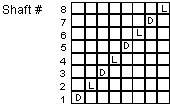
Basket Weaves in Double Weave
A loom with 8 or more shafts is required to produce double weave with both layers in basket weave structure. In this discussion the threading is straight draw on 8 shafts with dark warp threads on the odd numbered shafts and light colored warp threads on the even numbered shafts.
Threading

The tieup (or peg plan) is easy to develop. This example is for 2/2 basket weave in both layers of the double weave, with the dark warp threads 1357 in the top layer and the light threads 2468 in the bottom layer. The first diagram shows the shafts to be raised to weave the top layer and the second diagram shows the shafts to be raised to weave the bottom layer. The third diagram puts the first two together and adds with dots the shafts of the top layer that must be raised to weave the bottom layer.
The Development of the Tieup for 2/2 Basket Weave in Double Weave

The third diagram can be shown with numbers either as a tieup or a peg plan diagram.
Tieup Peg Plan

It is helpful to look at the first two grids from the tieup development in a slightly different fashion so that the drawdowns for the two layers can be presented separately. Remember the view is looking at the two layers from above. The top layer is discussed first.
Separation of the Tieups for Top and Bottom Layers

The usual method of progressing from the threading to the tieup, to the treadling, to the drawdown looks like this. The drawup is also shown because that is what a weaver see as the weaving develops on the loom.
Threading Tieup
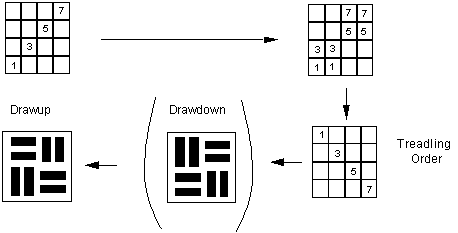
What does the bottom layer of the double weave look like when the woven cloth is turned over? There are several things that must be considered. First the threading is opposite in direction from what it is when looking from above. Second the tieup diagram changes to its complement because the warp threads that were not raised in the previous diagram appear to be raised when viewed from below. Therefore the tieup diagram takes this form.

Now the path from threading to drawdown can be carried out for the bottom layer with the recognition that the threading diagram must be reversed because the warp runs 8642 from left to right when viewed from below rather than 2468 from right to left when viewed from above.
Threading Tieup
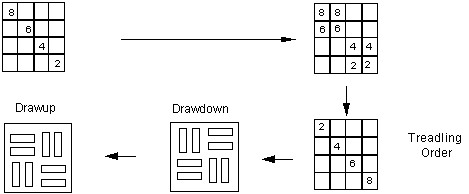
These examples illustrate how two successive weft shots occur in basket weave. In order to hold these shots in position it is necessary to hold them at the selvage edge. One way to do that is to use a floating selvage. Another way to accomplish this is always to cross the weft threads at the selvage. This works best when the weft shots alternate in the DLDL fashion shown here.
__________________________________________________________________
There are a large number of color and weave basket patterns that can be developed with a given peg plan through changing the treadling order. This is illustrated in the first four examples presented next In examples 4 and 5 below, the peg plans have been changed. The color order for the warp and weft remain the same for all the examples, that is DLDL, and the structure in both layers of the double weave is 2/2 basket weave.
The weave structures for these diagrams are presented as 4 x 4 grid drawups.
1. Peg Plan 1. 1357/2468 signifies warp threads 1357 in the top layer
warp threads 2468 in the bottom layer

2. Peg Plan 2.. 2468/1357. Reversal of the two layers.

3. Peg Plans 1 and 2. First half 1357/2468. Second half 2468/1357
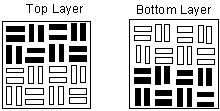
4. Peg Plan 3. 1357/2468

5. Peg plan 4. 2367/1458.

6. Peg Plan 5. 2367/1458

7. Peg plan 6. 2358/1467

_________________________________________________________________ _
The window design in double weave only requires an 8 shaft loom if both background and patten are woven in plain weave. If you want to weave the background in plain weave and the window in basket weave, the window design then needs a 12 shaft loom. If you want to weave both the background and the window in basket weaves, the window design calls for a 16 shaft loom.
Window Design in 12 Shaft Double Weave
A border or frame can be added to any of the 8 shaft designs already presented. An easy way to accomplish this is to designate shafts 9-12 for block A and shafts 5-8 for block B. Then any of the 8 shaft peg plans given in the last section can be used directly. The threading would have this two block threading format. Notice that it is possible to have plain weave structure in both blocks A and B. Block B can also be woven in basket weave.
12 Shaft Threading
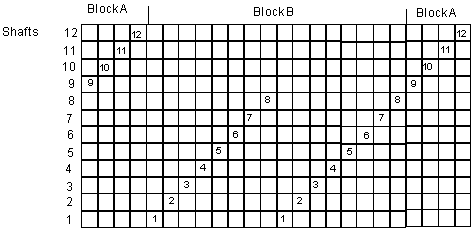
Two peg plans are needed. The first weaves plain weave for both blocks A and B in a 4 pick weft sequence. The second weaves plain weave for block A and basket weave for block B. The peg plan # 4 is used as the example of basket weave for the window design.
The Peg Plan to Weave Plain Weave for the Background

The Pag Plan to Weave Plain Weave for the Background
and Basket Weave for the Pattern
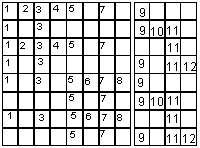
Schematic Representation of the Window Design

_________________________________________________________________ _
There are a number of other threadings that can be used in double weave where basket weave is the structure . For some of these threadings it is not possible to weave plain weave.
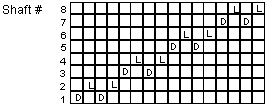
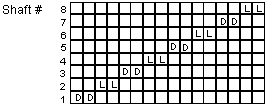

The last threading could be used for a 3/3 basket weave pattern and suggests how other basket weave structures could be developed.